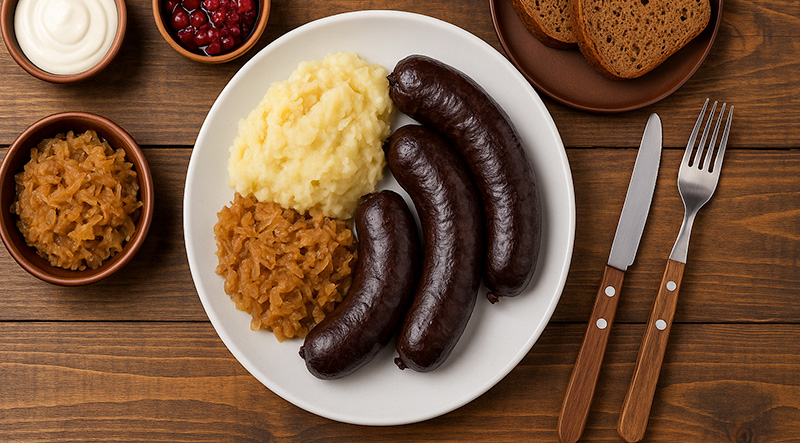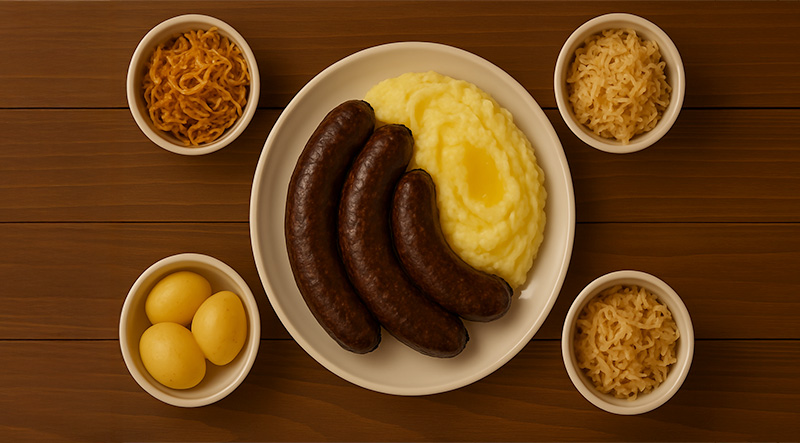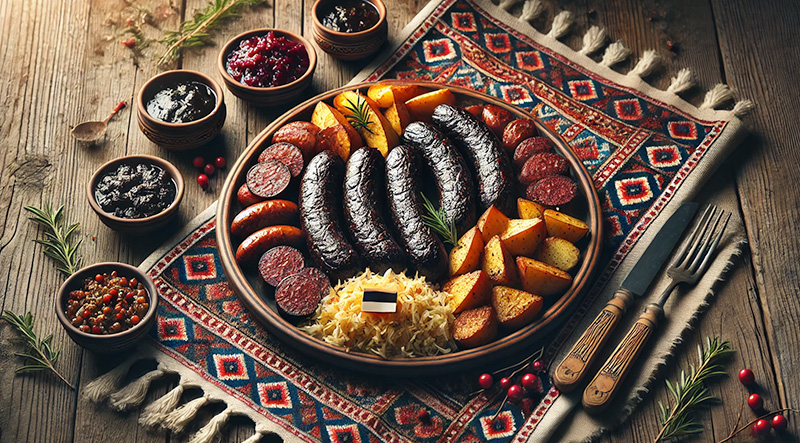Savory, rich, and steeped in tradition, **Verivorst** is Estonia’s beloved national dish that brings warmth and nostalgia to every festive table. These dark, flavorful **blood sausages**, packed with barley, pork, and spices, are a wintertime staple—especially during the Christmas season. Served hot alongside creamy mashed potatoes, tangy sauerkraut, and a spoonful of sweet-tart lingonberry jam, Verivorst is the ultimate comfort food. With its bold flavor and hearty texture, this iconic dish offers a delicious taste of Estonia’s rustic soul and deep-rooted culinary heritage. Read More...
The History of Verivorst – Estonia’s National Dish, A Dish of Heritage and Heart:
In Estonia, Verivorst is more than just a meal—it’s a cherished tradition that embodies the country’s agrarian roots, resourcefulness, and cultural pride. Often hailed as Estonia’s national dish, Verivorst is a type of blood sausage made from pork, barley, onions, and pig’s blood. Though it may sound unusual to some, this rich and flavorful delicacy holds a revered place in Estonian culinary heritage, especially during the colder months and the festive Christmas season.
Humble Beginnings in the Estonian Countryside:
The origins of Verivorst date back centuries to rural Estonia, where farming families lived closely with the land and livestock. Every part of the animal was used to minimize waste, especially during the autumn pig-slaughter season, known as sigu tapmine. This practical and respectful approach to food laid the foundation for dishes like Verivorst, where even the blood—a highly nutritious ingredient—was transformed into a flavorful sausage, combined with grains and spices to feed families through the long winters.
A Blend of Simplicity and Substance:
The traditional preparation of Verivorst reflects the rustic and hearty nature of Estonian cuisine. The sausage mixture typically includes cooked barley, caramelized onions, pork fat, and fresh pig’s blood, stuffed into natural casings and either boiled or baked. It’s often served with mulgikapsad (braised sauerkraut), potatoes, and a spoonful of lingonberry jam, balancing its savory richness with tang and sweetness. In some variations, the sausage is roasted in the oven until the casing becomes slightly crisp, adding another layer of texture.
The Christmas Table Staple:
Verivorst’s deep connection to Christmas makes it particularly significant in Estonia’s cultural calendar. It’s a must-have dish during holiday feasts, often prepared in large quantities and enjoyed with family and friends. The smell of roasting Verivorst in Estonian kitchens is as closely tied to the holiday spirit as Christmas trees and candles. For many, it evokes warm memories of childhood, family gatherings, and the comforting rhythm of seasonal traditions.
A Taste of Identity:
Despite modernization and international culinary trends, Verivorst remains proudly embedded in Estonian identity. It continues to be sold in markets, made at home, and featured in restaurants celebrating local cuisine. It also serves as a culinary ambassador among Estonian diaspora communities, preserving a strong connection to homeland traditions.
From its humble, practical beginnings to its festive role today, Verivorst tells a flavorful story of Estonia’s past and present. It’s a dish that honors heritage, sustains the spirit, and celebrates the deep ties between food, family, and national pride.
Cook the barley, Sauté the onions & Mix the filling:
Rinse the barley and boil in salted water until tender but still chewy (about 25–30 minutes). Drain and let it cool.
In a large pan, melt the butter or lard and sauté the onions until soft and golden. Let cool slightly before mixing.
In a large bowl, combine cooked barley, sautéed onions, chopped pork, diced fat, and all spices. Gently stir in the pig’s blood until the mixture becomes uniform and loose, like a thick batter. (Add garlic, grated apple, or a splash of cream now if using.)
Prepare the casings & Stuff the sausages:

Parboil the sausages:

Finish by baking or pan-frying:

Serve warm with traditional sides:
The entire process for preparing traditional Estonian Verivorst takes about 2 hours in total. Allow roughly 45 minutes of active prep time: 25–30 minutes to cook and cool the barley, 10 minutes to sauté the onions, and another 10 minutes to mix the filling and load it into casings. Cooking requires an additional 75 minutes—about 25 minutes of gentle parboiling to set the sausages, followed by a 20-minute rest and a final 20- to 30-minute bake or pan-sear to brown and crisp the skins—after which the aromatic blood sausages are ready to serve.
A single serving of **Verivorst** (approximately one sausage) contains around **300–400 calories**, depending on the ratio of pork, fat, and barley used. The pig’s blood adds iron and protein with minimal fat, while the pork shoulder and diced fat contribute to the majority of the calories through rich, savory fats and protein. Barley provides complex carbohydrates and fiber, and sautéed onions add mild sweetness and a small caloric boost. If served with traditional sides like potatoes, sauerkraut, or lingonberry jam, the total calorie count per meal could easily rise to **500–600 calories** or more.



